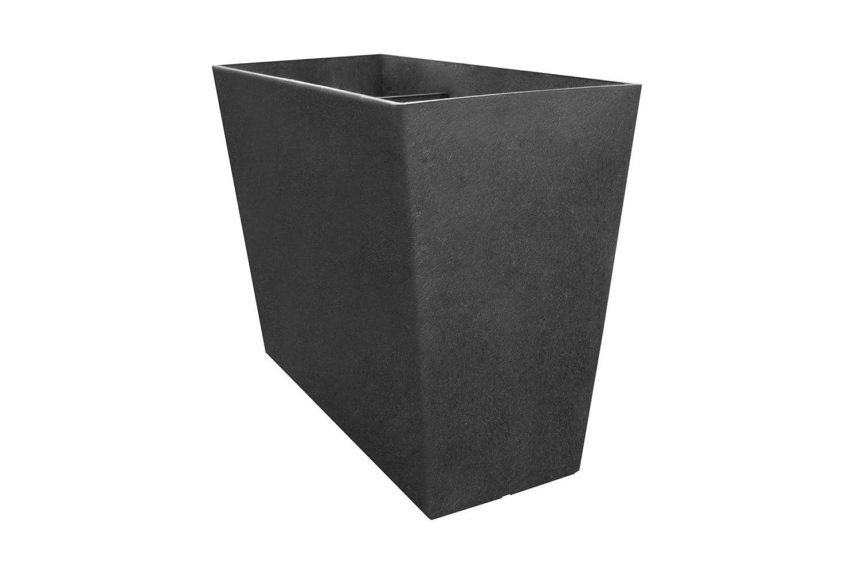If you travel frequently or just don’t have a green thumb, self-watering planters might be the solution to keeping your plants healthy. To find the best options, we tested a dozen planters over the course of four months, noting how easy they were to use and how well our plants fared.
But how exactly do they work? “Self-watering pots work by capillary action,” says Lisa Eldred Steinkopf, plant expert of The Houseplant Guru. “The water reservoir at the bottom of the planter is filled and the plant soaks it up from the bottom. If a wicking material is used, the wick draws the water up into the plant. The plant parent only has to keep the reservoir filled with water so that the plant can draw up the water.”
Whether you’re looking for a hanging self-watering basket for your parched petunias or a large, striking planter with a huge water reservoir for a sunny deck, the list below has something for every gardener.
What We Recommend
We tested a dozen popular self-watering planters on the market in our homes, evaluating each based on its effectiveness, design, ease of use, features, and price. To learn more about how we tested self-watering planters, check out our testing process below.
Though the Tierra Verde Sonata planter is made from recycled tires, it has the high-end appearance of fiberglass. It comes in seven different sizes and shapes, so you can find the perfect one for your space. We chose a classic rectangular design, which looked stylish and blended well into our space.
This trough-style planter is virtually indestructible—they’re designed to resist cracking and crumbling, even in freezing temperatures. The manufacturer even provides a 365-day no-cracking guarantee. There were no signs of weathering or damage at the end of the testing period.
We breezed through the setup; all that is required is to slide two divider panels into place, which help support the structure of the planter. If using outdoors, you’ll likely want to remove the drainage plugs to ensure the planters don’t get water-logged in heavy rain.
To refill the reservoir, we simply watered the soil and excess water collected in the reservoir below. We were very impressed at how these planters kept outdoor plants vibrant and healthy, even in hot 90 degree weather. We refilled the water reservoir of these planters every week or so, though it can be difficult to know when to refill because of the lack of a water gauge.
Product Details: Sizes: 4, 10.3, 12, 14, 18, 24, and 28 inches | Material: Recycled rubber | Indoor/Outdoor: Indoor and outdoor
Key Terms to Know
- Wicking: Absorbing or drawing off liquid using capillary action. This is how plants soak up water in self-watering planters.
- Oxygen circulation: Oxygen circulation is crucial for root health. Many self-watering planters have drainage holes or other design features to encourage air flow.
These pots from Gardenix are the best self-watering planters for the budget conscious. The nested pot set has an inner plant holder with legs to ensure your plants are lifted above the water, which helps prevent root rot. These planters also have a water-level indicator to help you know when it’s time to water.
This pot comes with coco coir soil as part of the self-watering system. Coco coir is made of coconut shell fibers and is known for its excellent water retention and drainage. This planting medium helps ensure your plant’s roots get oxygen as well as water. The manufacturer recommends you use regular potting mix in addition to the coco coir.
We were impressed by how easy this was to put together—it only took three minutes to assemble by placing the interior pot into the exterior pot and sliding the water indicator into place. To refill the reservoir, you simply pour water into the slot between the interior and exterior pots.
This pot is available in multiple colors: white, gray, purple, and teal. We loved that the pots didn’t look like plastic, but noted that the material looked like it may experience weathering if used outside.
Product Details: Sizes: 7 inches | Material: Plastic, polypropylene | Indoor/Outdoor: Indoor
If you’re looking to splurge, we think the Crescent Garden pot is worth it. The planter is designed with recycled, high-grade polyethylene to avoid fading in the hot summer sun and cracking in cold winters. Even though it’s made of a heavy-duty material, we found the planter surprisingly lightweight and easy to move. The double-walled design helps protect plant roots from extreme temperature changes and also offers additional reservoir space for water. These planters are built to last and the manufacturer offers a 10-year limited warranty.
You can go up to six weeks without watering with this planter, and it has a helpful water level indicator for easy monitoring. It comes in four sizes and 11 different colors in tasteful neutral shades. We liked that this planter resembled a clay pot and that it came ready to use out of the box—it even includes an instruction booklet with planting tips and a plant styling guide.
The reservoir was easy to fill from the rim of the planter; there is a drainage hole and it is recommended to remove the red waterproof plug to prevent overwatering when using outdoors. When the reservoir is full, a hidden overfill tube will drain out the excess water, helping to prevent root rot. The only downside we noticed was the price, but thought the high quality and longevity made it a worthwhile investment.
Product Details: Sizes: 18, 22, 26, and 30 inches | Material: High-density polyethylene | Indoor/Outdoor: Outdoor
For a stylish indoor option, we recommend the HBServices planter. It features a top pot with slotted cutouts on the bottom and hollow legs that are inserted into a reservoir. This design keeps the roots above the water, helping to prevent overwatering. The open slats on the bottom of the pot also help keep the roots oxygenated by encouraging air circulation, preventing root rot. To check the water level, simply lift the top up to check the water reservoir underneath.
The bottom reservoir saucer is functionally designed, with risers that lift it off the ground to prevent water stains on the floor. We also liked using the convenient watering clip to fill the reservoir.
Though this planter is made of plastic, it has color-fast properties and a glossy look that makes it appear similar to ceramic. However, it isn’t the most durable plastic, and it may crack or chip if dropped.
Product Details: Sizes: 8 inches | Material: Plastic, polypropylene | Indoor/Outdoor: Indoor
Hanging plants, especially those kept on porches, can be difficult to keep watered. They’re often under overhangs so they don’t receive rainfall, and to reach them, you may need to pull out a heavy step stool. A self-watering hanging planter is the perfect solution to keep your hanging outdoor plants hydrated.
This option has a classic wicker design that lends itself to virtually any space and includes a chain for hanging. The planter has a gauge with maximum and minimum lines, so it’s easy to tell if you need to add water. There’s also a water port for easy filling and a drainage plug. However, the port to add water is small, so it’s easy to miss when watering.
It only took a few minutes to set up; just insert the water-level indicator into its slot, put the liner into the outer shell, and hang. We liked that it had a removable inner liner that made it easier to plant and unplant. The planter and its chains held up well over the testing period without any issues.
The weather was very hot over the testing period, so we had to refill every other day or so since the water reservoir is small, which was a downside of this planter. The pot does have an overflow system that will drain out water when the reservoir is too full, which helps prevent waterlogged soil.
Product Details: Sizes: 10.75 inches | Material: Polyester | Indoor/Outdoor: Outdoor
This modern planter arrives as a set of three. They are made of durable plastic and sets come in nine different solid and speckled colors so you can select one that will easily blend into your decor.
The planter self-waters through a wicking cord, which must be installed at the bottom of the pot by feeding it through the drainage holes in the bottom of the planter. A wicking cord draws water up from the reservoir to the roots.
There isn’t a gauge or indicator, so to check the water level we had to physically look into the hole between the planter and the reservoir or stick our finger in to feel for water, which was inconvenient. However, we loved the clip-on funnel used to pour water into the reservoir.
Drainage holes at the bottom of the pot increase airflow to the roots for plant health. However, we found it difficult to lock the bottom water reservoir into place and even dropped the reservoir a few times. Because of this, we advise checking that it’s locked in place before filling with water.
Product Details: Sizes: 9,10, and 12 inches | Material: Plastic | Indoor/Outdoor: Indoor
This set of three rectangular planters are designed to be used on window sills and are great for growing herbs. Herbs, such as basil and thyme, typically require a lot of sunlight and will do best if placed in a sunny window. The planters are lightweight so they aren’t too heavy for a windowsill, even with a full water reservoir.
There’s a handy corner water-filling port, which you can use while the top pot is still in place to quickly fill the reservoir. There’s also a viewing window so you can easily check the water level inside the planter. These planters can last up to two weeks without watering and have two wicking strips per pot. Because the weather was hot during the testing period and we were using the pots outdoors, the water reservoirs needed to be refilled about every three days.
However, the planters overfilled easily when it rained, which could lead to root rot and plant damage. We also didn’t like that there was no easy way to drain excess water out of the planter. These factors led us to conclude that these planters are best used indoors.
Product Details: Sizes: 5.5 inches | Material: Plastic | Indoor/Outdoor: Indoor
The Winston Porter Cameron planter advertises all-weather durability with UV protection, and lives up to its promise. We thought this planter performed exceptionally well, lasting an entire winter outdoors without any cracks or fading. The plastic is coated with a plastic resin that gives it a nice matte finish and helps protect it from the elements. This planter comes in 14 different colors and eight sizes so you can customize it to fit your needs.
The self-watering disc in this planter helps prevent root rot and allows roots to receive oxygen. However, this planter does not come with pre-drilled drainage holes, so if you want drainage you will need to drill the holes yourself. We opted not to drill holes and did not experience any root rot or heavy overflow.
When kept outside, this planter rarely needed to be watered and the plants thrived. The planter is incredibly low-maintenance and durable.
Product Details: Sizes: 5.25, 7, 8.5, 10.25, 13.75, 15, and 17 inches | Material: Plastic, resin | Indoor/Outdoor: Both
The Bottom Line
The earth-friendly Tierra Verde Sonata planter provides both form and function and is the best overall self-watering planter. This stylish planter keeps plants well-watered and is virtually indestructible, designed to resist cracking and crumbling even in freezing temperatures.
Our Testing Process
Our testing team followed a step-by-step testing process to evaluate each planter, testing all the planters for a collective total of 5,184 hours. First, we unboxed the planters and set them up, noting if instructions were provided and how easy they were to follow as well as the time it took to set up. We observed the look and feel of the planters and whether they were made of high or low quality material.
Then, we planted the pots and placed them in our homes, using them over a period of weeks to months. We used the water indicator if the planter had one and recorded how easy it was to see the water level and refill the reservoir.
We rated the planters on the style and if it enhanced their space. They also noted if the design included drainage and ventilation to prevent root rot. We regularly checked the soil moisture to see if the planter was self-watering effectively and observed if their plants showed any signs of distress or health.
At the end of the testing period, we recorded any damage or weathering the planters experienced. We also noted our overall experience with the planter, and whether we thought it was worth the price.
Better Homes & Gardens
What to Know About Self-Watering Planters Before Shopping
Wicking Method
Self-watering planters work in two different ways.
Some self-watering planters utilize a wick to keep the soil inside moist. “A wicking material can be used to wick-water a plant,” Eldred Steinkopf says. “Acrylic string or yarn is the best wick to use. Cotton can be used, but it rots, so is not the best choice.”
She adds that wicks can be placed in the pot, either inside the bottom or up the side, as long as none of the string hangs from the top of the soil, as that will wick water out of the plant. The wick then hangs out a drainage hole into a water container, wicking up water into the potting mix.
Other self-watering pots have no wick, and instead the roots drink directly from a water reservoir at the bottom of the pot.
In this case, “the plant roots draw the water up into the soil from the reservoir,” Eldred Steinkopf says. “Usually, there is a tube in the pot that you pour the water into to keep the reservoir full. There may also be an indicator that reminds you the reservoir is empty,” she says.
Refill Frequency
The frequency with which you’ll need to refill your self-watering planter depends primarily on the size of the reservoir. A large reservoir that can hold a lot of water may not need to be refilled for up to six weeks, while smaller reservoirs may need to be refilled every few days.
Eldred Steinkopf cautions, “Just because they are ‘self-watering,’ remember you still have to fill the reservoirs; this may be a longer or shorter period depending on the light levels, the type of plant, and the temperature.”
Better Homes & Gardens
Oxygen Circulation
Oxygen circulation around the roots is crucial to prevent root rot and to have a happy, healthy plant. Self-watering planters encourage air circulation in a few different ways, including drainage holes and slotted bottoms.
Material
Most self-watering planters are made of synthetic materials, such as plastic or rubber. These materials are often engineered to avoid sun-bleaching in the summer and cracking in the cold winter months. However, some plastics are better than others, and lower-quality plastic pots will do best indoors.
Other Self-Watering Planters We Tested
Lechuza 15392 Cube Cottage Self-Watering Planter
While we loved the stylish design and the durability of this Lechuza planter, it did fall short, as the instructions for assembly were primarily in German.
Keter Urban Bloomer 12.7 Gallon Raised Garden Bed with Self Watering Planter Box and Drainage Plug
This Keter planter disappointed us, as it felt flimsy and low quality—it even fell over on a windy day and damaged the plants. It was also unclear how to best use the planter, and the easy assembly did not make up for these shortcomings.
City Pickers 24,5 in. x 20.5 in. Patio Raised Garden Bed Grow Box Kit
This planter from City Pickers had a somewhat complex set-up, and to make it more complicated, the instructions arrived damaged and difficult to follow. In addition, the self-watering feature did not work and the plants in the pot quickly showed signs of distress. We did appreciate that the planter included wheels for easier movement.
Better Homes & Gardens
Your Questions, Answered
Can you overwater with self-watering pots?
While outdoor planters that have drainage holes or overflow systems are unlikely to be over-watered, self-watering planters used indoors with their drainage holes plugged are at risk for over-watering.
“If the potting mix is too heavy, meaning it is a mix that holds a lot of water, the plant could have too much water around its roots,” Eldred Steinkopf says. “This is especially true for inside plants—it may not be a big concern outside.”
In addition, she says you can over-water if the wick is too thick and it takes up too much water into the root area.
What plants are not suitable for self-watering pots?
While most plants are suitable for self-watering planters, Eldred-Steinkopf advises, “I would not use self-watering pots for cacti or other succulents…they have shallow root systems and prefer not to be moist all of the time.”
Do self-watering planters cause root rot?
Root rot can happen under many circumstances, not just with self-watering planters. “The soil mix used in the planter would be the reason for the rot,” Eldred Steinkopf says. “Also, choosing the wrong plant or the wrong thickness of wicking could result in root rot.”
Who We Are
This article was written by Better Homes & Gardens contributor Rachel Ahrnsen. She is a Master Gardener who spent hours researching self-watering planters. To write this article, she utilized testing insights from BHG’s in-house testing team. She also consulted Lisa Eldred Steinkopf, a houseplant expert who runs the The Houseplant Guru blog.
What is BHG Recommends?
Next to all of the products on this list, you may have noticed our BHG Recommends seal of approval. Products that earn the seal have been put through rigorous testing to make sure they’re worth a spot in your home. We buy most of the products we test ourselves, but occasionally we are provided samples by companies if buying isn’t an option. In these cases, we use the same testing criteria we use to test the purchased products.


:strip_icc()/gardenix-decor-self-watering-planter-bd2301cf91554ced878dbd3bcdd4e448.jpg)
:strip_icc()/crescent-garden-rim-trudrop-18-inch-planter-e714312e93f94a7b9db39a51baef5b7d.jpg)
:strip_icc()/hbservices-self-watering-pot-004c043a3bca4688b213fd5f851f3b8a.jpg)
:strip_icc()/garden-851921924ced470f9856036a5ed232f1.jpg)
:strip_icc()/ouez-55a82101b12c491b9b0164e26f9028ec.jpg)
:strip_icc()/Amazing-Creation-Window-Herb-Planter-Boxes-3-Pack-6147a5cd65244655b48e204a7ed1ed95.jpg)
:strip_icc()/winston-porter-carmeron-planter-8e2751c6c8c44e259a09da61735e1fc9.jpg)




